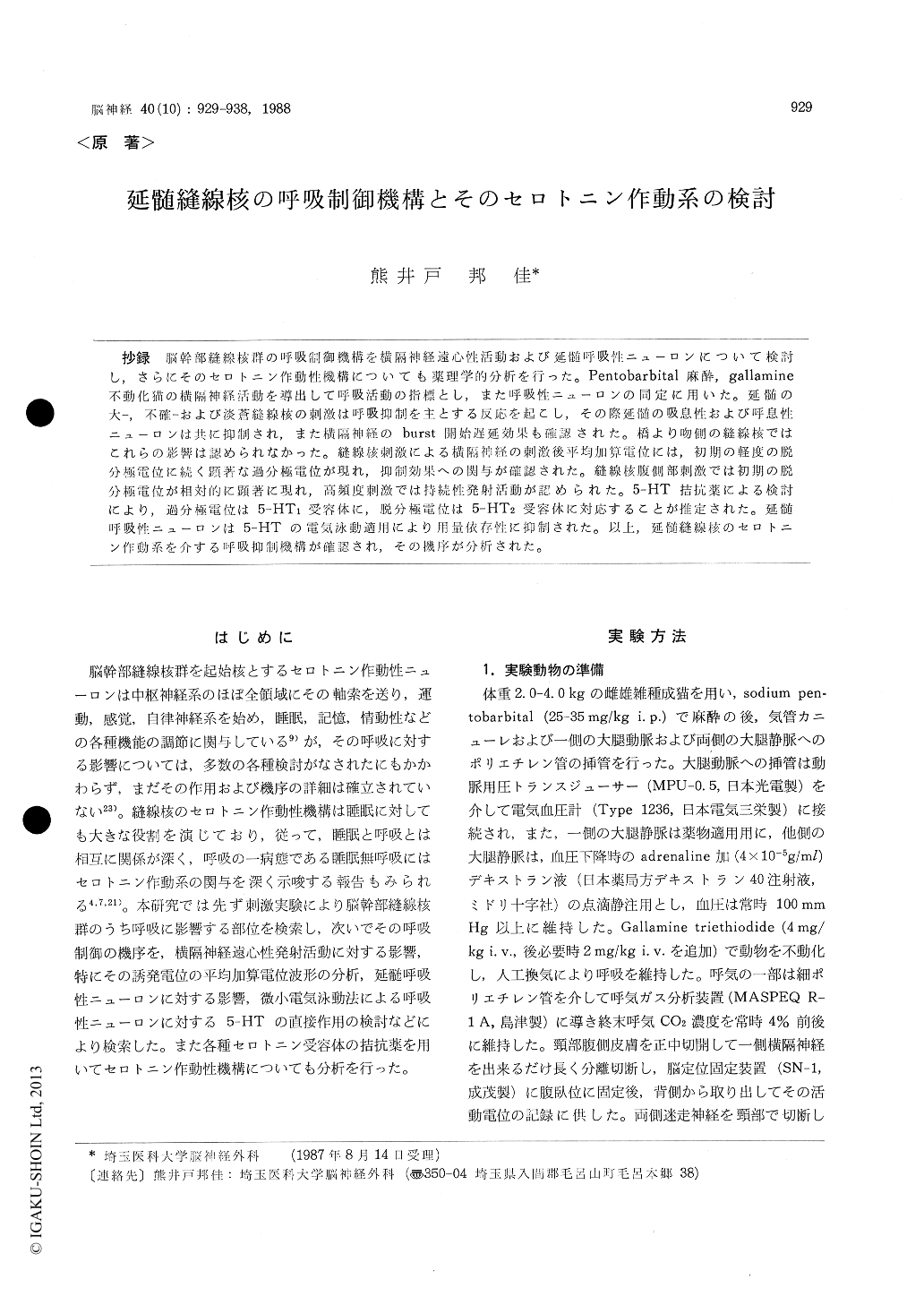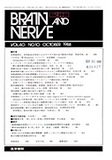Japanese
English
- 有料閲覧
- Abstract 文献概要
- 1ページ目 Look Inside
抄録 脳幹部縫線核群の呼吸制御機構を横隔神経遠心性活動および延髄呼吸性ニューロンについて検討し,さらにそのセロトニン作動性機構についても薬理学的分析を行った。Pentobarbital麻酔,gallamine不動化猫の横隔神経活動を導出して呼吸活動の指標とし,また呼吸性ニューロンの同定に用いた。延髄の大—,不確—および淡蒼縫線核の刺激は呼吸抑制を主とする反応を起こし,その際延髄の吸息性および呼息性ニューロンは共に抑制され,また横隔神経のburst開始遅延効果も確認された。橋より吻側の縫線核ではこれらの影響は認められなかった。縫線核刺激による横隔神経の刺激後平均加算電位には,初期の軽度の脱分極電位に続く顕著な過分極電位が現れ,抑制効果への関与が確認された。縫線核腹側部刺激では初期の脱分極電位が相対的に顕著に現れ,高頻度刺激では持続性発射活動が認められた。5-HT拮抗薬による検討により,過分極電位は5-HT1受容体に,脱分極電位は5-HT2受容体に対応することが推定された。延髄呼吸性ニューロンは5-HTの電気泳動適用により用量依存性に抑制された。以上,延髄縫線核のセロトニン作動系を介する呼吸抑制機構が確認され,その機序が分析された。
Respiratory control mechanism of the medullary raphe nuclei were studied with some references to their serotonergic mechanisms. Anesthetized, paralyzed and artificially ventilated cats were used and their phrenic nerve efferent activity was al-ways observed as an indicator of central respira-tory activity. Following results were obtained.
1) Electrical stimulation of medullary raphe nuclei, namely, nucleus raphe magnus, obscurus and pallidus, produced dominantly inhibitory responses in the phrenic nerve activity, while raphe stimula-tion in the pons and more rostral portion did notproduce any respiratory responses. The blood pressure was depressed by raphe stimulation, too, almost in parallel to the respiratory inhibition. These inhibitory responses in respiration and blood pressure were partially antagonized by cyproheptadine (0.3-0.5 mg/kg i. v.) and methyser-gide (0.3-0.5 mg/kg i. v.).
2) Raphe stimulation inhibited remarkably ac-tivities of the medullary inspiratory and expira-tory neurons, similarly.
3) In the experiment, where single shot stim-ulus was added to the raphe nuclei at the various time point in the respiratory phase, raphe stimula-tion showed the retardative effect of inspiratory switching, in addition to the inhibitory effect of phrenic burst activity.
4) The mechanism of respiratory inhibition produced by raphe stimulation was analyzed by evoked potentials in the averaged phrenic nerve activity. The post-stimulus averaged potentials of the phrenic nerve consist of the depolarizing potentials of about 10 msec duration and the sub-sequent hyperpolarizing potentials of several 10 msec duration, the duration time depending on the stimulus intensity. When stimulation was given in high frequency, the post-stimulus averaged poten-tial became flattened, and the phrenic burst acti-vity was inhibited almost completely. But in thecase of stimulation in ventral parts of the raphe nuclei, the initial depolarizing potential was com-paratively more prominent, and when high fre-quency stimulation was given, continuous firing was observed in the phrenic nerve activity. At the time of the continuous firing, respiratory rhythmicity was disappeared completely.
5) Propranolol (0.3-1.0 mg/kg i. v.), which have been recognized to have 5-HT1 antagonistic activity, reduced the hyperpolarizing potentials of the post-stimulus averaged potentials, and methy-sergide (0.3-1.0 mg/kg i. v.), 5-HT1 and 5-HT2antagonist, reduced both depolarizing and hyper-polarizing potentials. These phenomena would suggest strongly that hyperpolarizing and depola-rizing potentials are related to the 5-HT1 and 5- HT2 receptors, respectively.
6) Iontophoretic application of 5-HT (30-150 nA) produced dose-dependent inhibitory effects to almost all of the medullary inspiratory and ex-piratory neurons, similarly.
From these results it is suggested that medullary raphe nuclei modulate the respiratory activity through the serotonergic mechanisms, and that 5-HT1 receptor mechanism works principally on the respiratory inhibition produced by raphe stimula-tion.

Copyright © 1988, Igaku-Shoin Ltd. All rights reserved.


